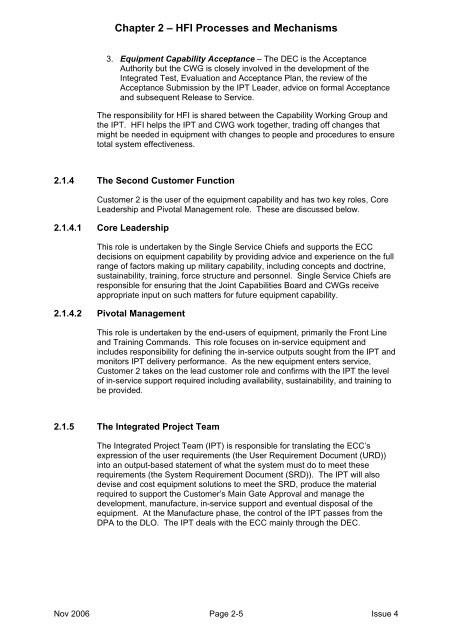MAP-01-010 HFI Management Guide - Human Factors Integration ...
MAP-01-010 HFI Management Guide - Human Factors Integration ...
MAP-01-010 HFI Management Guide - Human Factors Integration ...
Create successful ePaper yourself
Turn your PDF publications into a flip-book with our unique Google optimized e-Paper software.
Chapter 2 – <strong>HFI</strong> Processes and Mechanisms<br />
3. Equipment Capability Acceptance – The DEC is the Acceptance<br />
Authority but the CWG is closely involved in the development of the<br />
Integrated Test, Evaluation and Acceptance Plan, the review of the<br />
Acceptance Submission by the IPT Leader, advice on formal Acceptance<br />
and subsequent Release to Service.<br />
The responsibility for <strong>HFI</strong> is shared between the Capability Working Group and<br />
the IPT. <strong>HFI</strong> helps the IPT and CWG work together, trading off changes that<br />
might be needed in equipment with changes to people and procedures to ensure<br />
total system effectiveness.<br />
2.1.4 The Second Customer Function<br />
Customer 2 is the user of the equipment capability and has two key roles, Core<br />
Leadership and Pivotal <strong>Management</strong> role. These are discussed below.<br />
2.1.4.1 Core Leadership<br />
This role is undertaken by the Single Service Chiefs and supports the ECC<br />
decisions on equipment capability by providing advice and experience on the full<br />
range of factors making up military capability, including concepts and doctrine,<br />
sustainability, training, force structure and personnel. Single Service Chiefs are<br />
responsible for ensuring that the Joint Capabilities Board and CWGs receive<br />
appropriate input on such matters for future equipment capability.<br />
2.1.4.2 Pivotal <strong>Management</strong><br />
This role is undertaken by the end-users of equipment, primarily the Front Line<br />
and Training Commands. This role focuses on in-service equipment and<br />
includes responsibility for defining the in-service outputs sought from the IPT and<br />
monitors IPT delivery performance. As the new equipment enters service,<br />
Customer 2 takes on the lead customer role and confirms with the IPT the level<br />
of in-service support required including availability, sustainability, and training to<br />
be provided.<br />
2.1.5 The Integrated Project Team<br />
The Integrated Project Team (IPT) is responsible for translating the ECC’s<br />
expression of the user requirements (the User Requirement Document (URD))<br />
into an output-based statement of what the system must do to meet these<br />
requirements (the System Requirement Document (SRD)). The IPT will also<br />
devise and cost equipment solutions to meet the SRD, produce the material<br />
required to support the Customer’s Main Gate Approval and manage the<br />
development, manufacture, in-service support and eventual disposal of the<br />
equipment. At the Manufacture phase, the control of the IPT passes from the<br />
DPA to the DLO. The IPT deals with the ECC mainly through the DEC.<br />
Nov 2006 Page 2-5 Issue 4
















